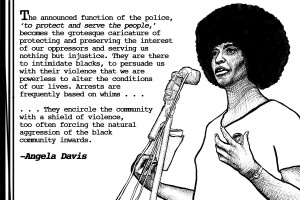Where The Girls At? Invisibility and Police Violence
All of the partygoers were taken to the Englewood police station where Mrs. Robinson said that the eight women who were among those arrested “were subjected to indignities” including physical assault and verbal abuse (i.e. being called racial epithets). Apparently the police officers who raided the party had helped themselves to some beer while there and started drinking when they arrived at the station.
Mrs. Robinson’s injuries from her mistreatment were bad enough that she was hospitalized. She identified a Detective Franck Hackel as her chief tormentor.
In 1999, Tyisha Miller was on her way to a party with her cousin when her car got a flat tire. They pulled into a gas station in downtown Riverside, California. Her cousin went to get help and left Tyisha who had been drinking alone in the car. Miller apparently passed out with the doors locked. She had a handgun on her lap.
A few minutes later, four Riverside police officers (all of them white) who had been called to the scene tried to wake Tyisha to no avail.
They smashed the driver’s side window and chaos ensued. At least one of the cops thought that he saw Tyisha reach for her gun. The officers fired 27 shots into the car and Miller was hit 12 times. She died.
There are countless stories of other women (and gender nonconforming people) who have experienced police violence. Yet, these stories often take a backseat to the police brutality experienced by black and brown men. As the brilliant Andrea Ritchie (2006) has written:
“To date, public debate, grassroots organizing, litigation strategies, civilian oversight, and legislative initiatives addressing police violence and misconduct have been almost exclusively informed by a paradigm centering on the young Black and Latino heterosexual man as the quintessential subject, victim, or survivor of police brutality (p.139).”
Joy James (1996) adds that: “The death of women in police custody by means of law enforcement measures to discipline and punish is an issue rarely raised in feminist explorations of women and violence or masculinist explorations of racism and policing (p.31).” I have certainly been guilty of this. I have written in the past about the fact that my own internalized sexism has often led me to minimize state violence against women and girls.
A few days ago, someone tweeted a video of a young woman being treated unnecessarily roughly by police officers in Brooklyn during a protest over the killing of Kimani Gray. Warning: The video is very disturbing.
As I listened to the young woman’s screams, I thought back to all of the young women I’ve worked with over the years. I remembered countless stories that they shared about being “hassled” by the cops. I remembered how much they worried about their brothers, fathers, boyfriends, and friends getting shot or killed by law enforcement. Yet when the narratives about police violence are written, most often these young women’s voices are missing.
Some young women have been and are speaking up to break the silence around the impact of state violence on their lives. The Young Women’s Empowerment Project (YWEP), for example, has documented encounters with the police through their Bad Encounter Line (BEL) report and zines. The following is a story that appears in BEL Zine #3:
I was walking to the bus when a police officer called out and said, “Hey you come here girl with all of that ass.” I ignored the comment unaware of where it was coming from until he pulled up on the curb to block my path in his undercover cop car. He jumps out and yells ‘didn’t you hear me calling you girl? I replied by simply saying no, my name isn’t aye girl with all that ass.’ He got really mad and slapped me saying that I was very disrespectful and do I know who he is and what he can do to me?…
The story escalates with the police officer sexually assaulting the young woman. She ends up getting arrested and jailed herself when she reports him. There is anecdotal evidence that the War on Drugs has actually increased police harassment and brutality against women. In light of this, I hope that even more women and girls will take YWEP’s lead and share their stories about encounters with the police.
This evening, I am proud to moderate a discussion about the invisibility of police violence against women & girls. We will be discussing the case of Rekia Boyd & others. If you are in town and are interested in these issues, you are invited to join us. Details are here.

